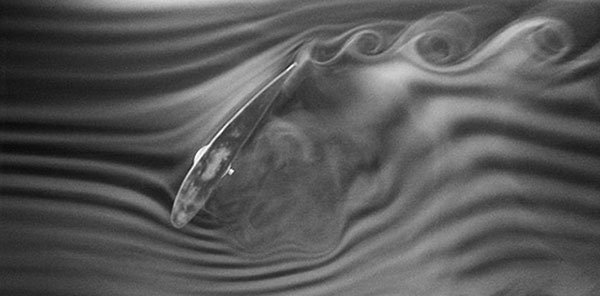Snakelike Zaps To Flowing Air Can Improve Vehicle Aerodynamics

(ISNS) -- The way air flows over surfaces can slow cars down and make airplanes loud when they fly over homes. Now scientists find that it's possible to reduce this drag by using curved electronic devices to generate electrically charged particles that control the flow of air over the surfaces of vehicles.
In physics, a plasma is a soup of electrically charged particles. It's the same form of matter found in lightning and stars. It can be created by applying an electric field to a gas — for instance, between two electrodes glued onto a surface.
By positioning electrodes in an irregular, asymmetric arrangement, one can make the plasma that forms between them move, and push air into flowing along with it. "The air flow induced in this manner could be several meters per second — say, 10 to 20 miles per hour," said researcher Subrata Roy, an applied physicist at the University of Florida in Gainesville.
Scientists reasoned devices that manipulate plasmas could help control the flow of air over surfaces, such as aircraft or automobiles. These plasma actuators could in principle increase lift and reduce drag for safer, quieter and more powerful vehicles. Unlike standard ways of controlling air flow over surfaces, such as fins or flaps, plasma actuators have no moving parts, and can be switched off when they are not needed.
The problem with such technology? Plasma can be very inefficient at influencing air flow. "For example, only one in 100,000 air particles get bombarded by energetic ions," Roy said.
As such, researchers wanted to find a way to connect plasma actuators with air flow as best as possible. While straight, linear actuators can only generate puffs of air in one direction, Roy and his colleagues reasoned wavy, serpentine actuators could produce puffs of air in every direction, improving their chances of coupling with air flow.
In experiments, they sent smoke lit by green lasers over airfoils, revealing that serpentine plasma actuators could indeed help control the three-dimensional flow of air over those surfaces in highly complex, versatile ways.
Get the world’s most fascinating discoveries delivered straight to your inbox.
"When we first saw the incense smoke green with laser light literally curling up in all directions, I was truly thrilled," Roy said. "Generally, in our work, we do not believe it till we see it, so that was the moment of truth."
Serpentine plasma actuators could help control whether air flows over a surface in a turbulent or in a streamlined, laminar way. They could also help keep air flow attached to a surface — the separation of flow from a surface increases the drag it feels and thus wastes energy that might ordinarily go to movement. In addition, they could generate vortexes in a flow to enhance mixing within it, which could help air and fuel mingle in a combustion engine.
"This uses interesting physics to manipulate flow and produce some meaningful, very desired results that have the potential to improve the performances of vehicles," said aerospace engineer Konstantinos Kontis at the University of Glasgow in Scotland, who did not take part in this research. "It's unique and novel — I've never seen it before. I find this technology really exciting."
One challenge Kontis noted plasma actuators face is the real world. "How might they behave under icy conditions or rainy conditions, or when they go through clouds? Is their performance compromised?" Kontis asked. "We need to understand how these devices work under these challenging conditions, under these more realistic conditions. This could be tested in unmanned aerial vehicles."
Future research will investigate how the vortexes of air that a serpentine plasma actuator generates modify the surrounding air flow. "This will allow betterment of its performance for eventual transfer of laboratory knowledge to practical industrial applications," Roy said.
Roy and his colleague Mark Riherd detailed their findings in the Aug. 28 issue of the Journal of Applied Physics.
This story was provided by Inside Science News Service. Charles Q. Choi is a freelance science writer based in New York City who has written for The New York Times, Scientific American, Wired, Science, Nature, and many other news outlets. He tweets at @cqchoi.

